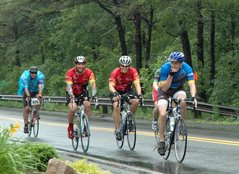Cycling Etiquette
- Obey all traffic signs and signals. This includes traffic lights and stop signs.
Communicate with your fellow riders, using proper cycling terms, such as “On your left,” “Car back,” etc. - Car back ... move to single file on the right hand side of the road or shoulder. Give way to the car... they are bigger than you and they will win.
- On your left ... allow the person coming up behind you to pass safely within the lane; not crossing over into the other lane. If necessary move to the right.
- Stay to the right, except to pass. Pass on the left side only. Do not pass on the right.
Do not cross center line regardless of passing zone. - Use proper signals when turning. Make left turns from the center of the road or left turn lane. Cross railroad tracks at right angles.
- Ride in control of your bike at all times (i.e. being able to stop within a reasonable distance.)
- Ride defensively, in consideration of your fellow riders.
- Don't use Aero bars in a group.
- Point out and call out any road hazards ahead. These include potholes, drain grates, stray animals, opening car doors, sticks or stones, parked cars, etc.
- Do not overlap wheels. A slight direction change or gust of wind could easily cause you to touch wheels and fall.
- Pedal down hill when you are at the front of the bunch. Cyclists dislike having to ride under brakes.
- When climbing hills, avoid following a wheel too closely. Many riders often lose their momentum when rising out of the saddle on a hill which can cause a sudden deceleration. This can often catch a rider who is following too closely, resulting in a fall from a wheel touch.
- Follow the instructions of Ride Marshals.
MS 150 Tips - Vocal Warnings - Slowing - When someone yells out "Slowing", this means that there is something that is causing the pack to slow down. This can be anything from a light, a slower pack of bikes, a car up ahead. In any event, prepare to slow down. Tap you brakes and repeat the yell "Slowing". This is to indicate to others that you've heard them and you are also slowing. This will also alert those behind you that you are slowing down.
- Stopping - When someone yells out "Stopping", this means that there is something that is causing the pack to stop. This can be anything from a light, a slower pack of bikes, a stop sign or a car up ahead. In any event, prepare to stop. Tap you brakes and repeat the yell "Stopping". This is to indicate to others that you've heard them and you are also slowing to a stop. This will also alert those behind you that you are slowing to a stop. It's VERY important not to slam on your brakes especially if there are others behind you!!
- Hold your line - When someone yells, "Hold your line", this means that you need to stay in a straight line as best you can. In most cases, the person yelling this out to you is attempting to pass. If you swing out or if you don't keep your bike steady, you could cause the other bicycler trouble.
- On your Left - When someone yells, "On your Left", this means that they are passing you on your left. No need to take this personally. Let them pass as they have the right of way. You should never hear "On your Right". That is, a bicycler should never pass on the right. However, there are many bicyclers with varying experience. Be on the look out for those that will pass on your right. If someone does this, kindly remind him or her that they should pass on the left. Also, it is common courtesy to say "Thank You" to the person yelling "on your left". This indicates to them that you've heard them.
- Car Up - When someone yells, "Car Up", this means that there is a car up front. It is intended to be a verbal caution indicating that a stop may be necessary. If you hear this, repeat the call so that others know that you are aware of the vehicle up front. It is also common courtesy to repeat this so that others behind you also know about the car.
- Car Back - When someone yells, "Car Back", this means that there is a car up back. It is intended to be a verbal caution indicating that a stop may be necessary. If you hear this, repeat the call so that others know that you are aware of the vehicle is behind you. It is also common courtesy to repeat this so that others behind you also know about the car.
MS-150 SAG Signal... To signal Support And Gear vehicles follow these three steps: - Off Road. Move out of the path of other riders.
- Off Bike. Stand or sit nearby.
- Wave Helmet.



_DET_4209.JPG)
